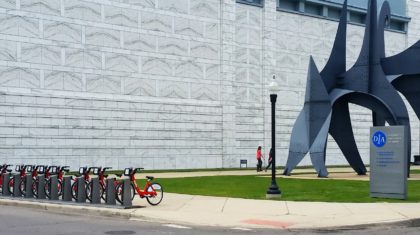
By Derek Hofbauer, Dana Dickman, and Jessica Roberts, Alta Planning + Design
“Oh, I just bike to work — that’s not exercise!” “I walk between meetings a lot, but that’s not the same as being active.” “This is a transportation project, not a public health project.”
People don’t often make the link between transportation and public health during the daily commute. In particular, transportation options (sometimes called Transportation Demand Management, or TDM) programs are too often posed as solutions to congestion, while their benefits to health are overlooked. Research has shown that people who drive less often are far more likely to get enough physical activity in their daily lives. In short, getting people out of cars can lead to big gains for fitness.
Transportation options practitioners are increasingly looking for opportunities to join forces with health researchers to measure active transportation health benefits. The link between active transportation and health seems like a no-brainer: more walking, biking and transit leads to increased community health benefits. However, researchers have often found it difficult to quantify health benefits from programs that encourage active transportation…until recently.
In 2009, Dr. James Woodcock and a team of researchers developed an Integrated Transport and Health Impact Modelling Tool (ITHIM) that can be used to measure the health impacts of increases in bicycling, walking, and transit. ITHIM measures physical activity and air pollution exposures by comparing levels of physical activities among different scenarios. A method is then used to estimate health outcome changes (Woodcock et al., 2013). The purpose of ITHIM is easy to explain but the way it works “under the hood” is complex. In Oregon, the state Department of Transportation (ODOT) partnered with the Oregon Health Authority (OHA) to prepare and apply ITHIM to measure the public health benefits from behavior change (Individualized Marketing) programs in the state. This was a fortuitous collaboration between two state agency departments that were interested in bridging the gap between transportation and health.
Individualized Marketing (IM) programs offer households (typically in a targeted neighborhood) transportation resources and events with the goal of reducing drive-alone trips and encouraging greater use of transportation options. Before and after surveys measure changes in travel behavior resulting from the program, which makes IM programs ideal candidates for ITHIM modeling and analysis. The changes in transportation behavior measured from area-wide travel diary surveys can be used as inputs for ITHIM. Results show important health indicators such as increased minutes and distances for walking and bicycling trips, as well as monetary savings resulting from decreased burden of disease (Woodcock et al., 2009).

The “Drive Less Save More: SouthTown” Individualized Marketing Program conducted in Corvallis, Oregon showed a 3.8% reduction in the drive-alone mode share, a 2.2% increase in transit, and a 1.4% increase in walking. After inputting the data into ITHIM, we additionally could state that the program resulted in a decrease of -2.1 Disability Adjusted Life Years (a 0.44% decrease in the burden of disease) among target area residents, which was valued at $115,300. The model also showed other health-related outcomes for SouthTown residents in the target area:
- Participants increased their walking by an average of about 1.25 miles per week.
- The average increase in physical activity was about 4 minutes per person per day, nearly 20% of the recommended 150 minutes per week.

The data churned out by the model is impressive — never before in Oregon have cost-related health benefits been directly attributed to mode shift changes from an IM program. The $115,300 savings from a decrease in the burden of disease equaled roughly three-quarters of the entire IM program budget. The IM program nearly paid for itself due to the health savings outcome alone. The big takeaway here is that small increases in active transportation lead to big savings in community health and that health and transportation researchers should be looking for new opportunities to work together, collect these types of data, and share their successes with academics and funders.
Now that the connection has been made between IM programs and ITHIM, it is worth exploring how this all happened and why. The story begins with a unique partnership that was developed between two distinct, yet very different state agency departments. Collaborative efforts among staff at ODOT and OHA led to the development of an Oregon-specific ITHIM for use in evaluating transportation options programs by incorporating county-level population distributions and health data.
ODOT was initially motivated to further develop the health tool for two major reasons: 1) A desire to promote the strong connection between transportation choices, physical activity, and health and healthcare costs, and 2) interest in making a strong benefit case for transportation investments that lead to increased active transportation. Although the tool is “tuned” for use in Oregon, the approach can be applied to other locations. Over the next couple of years, ODOT (in partnership with OHA) expects to work on broadening the use of the tool for transportation options programs, and possibly in other contexts as well. Thus, the link between the health and transportation sectors is growing stronger, especially in Oregon, and the data is here to prove it.
References:
“Drive Less Save More: SouthTown,” 2014. Retrieved on 4/25/16 from http://www.oregon.gov/ODOT/PT/PROGRAMS/transportation-options/DLSM-2014-CorvallisSouthTown-Final-Report.pdf on 4/25/16.
Woodcock J, Edwards P, Tonne C, Armstrong BG, Ashiru O, Banister D, et al. 2009. Health and Climate Change 2 Public Health Benefits of Strategies to Reduce Greenhouse-gas Emissions: Urban Land Transport. Lancet 374: 1930–1943.
Woodcock J, Givoni, M, Morgan, A et al. 2013. Health Impact Modelling of Active Travel Visions for England and Wales Using an Integrated Transport and Health Modelling Tool (ITHIM): PLoS One. v. 8(1). Retrieved on 4/25/16 from http://www.ncbi.nlm.nih.gov/pmc/articles/PMC3541403/


